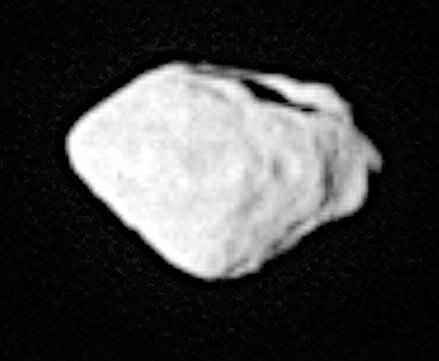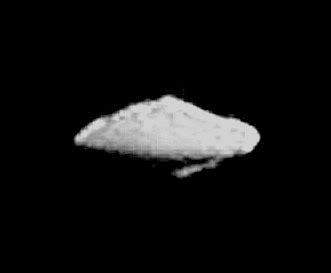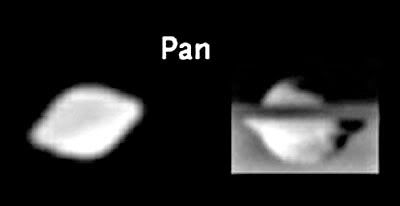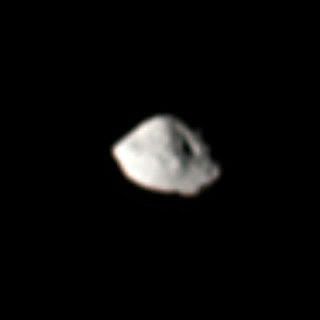It looks like you're using an Ad Blocker.
Please white-list or disable AboveTopSecret.com in your ad-blocking tool.
Thank you.
Some features of ATS will be disabled while you continue to use an ad-blocker.
11
share:
First, here are two objects that have been named Atlas and Pan, orbiting Saturn. Their shapes are indeed strange and the only
‘moons’ in the Solar System to resemble ‘Flying Saucers’, as can be seen in the pics below.
Atlas
Highest resolution image taken by Cassini
140,000km from Atlas. Motion blur reduced.
Image Source: Calvin J Hamilton
Solarviews
Pan
This image of Pan was taken from 209,000 km away.
Courtesy: NASA/JPL
Needless to say, scientists have concluded they are natural Moons that have strange shapes as a result of ‘accumulating ring particles’ around Saturn. But that’s the theory. The proof would be confirming that the moonlets and the rings near them have the same composition, but that still needs to be done. What if they are of different composition? And what if the theory is wrong?
But why do only these two moons have these strange ‘flying saucer’ shapes in the Solar System? Could they be derelict space craft that have now been covered with layers of dust?
As always, the best for the last!
Steins
Now for another object, an asteroid, named Steins
Located in the main asteroid belt between Mars & Jupiter, Asteroid 2867 Steins was selected as a scientific target to be observed, and flown by, during the cruise phase of the Rosetta mission. It is a rare, E-type asteroid of which little is known. On its 10 year journey to the comet 67P, the spacecraft flew past asteroid 2867 Steins in Sep 2008.
A Conspiracy?
When the moment arrived to take close-up images of Steins with the NAC, there was a…
Here is what happened as per Rosetta's log:
>So how did a million dollar NAC camera malfunction just at and during the crucial moments when it was most required?
>How and why did the high-gain antenna stop tracking the Earth with a loss of the telemetry signal at the precise moment?
> How come the FDIR was re-enabled one hour and twenty minutes after the asteroid loop tracking?
> And surprisingly the high gain antenna resumed tracking by acquisition of the telemetry signal 16 min after the asteroid fly-by!
Now is this all coincidence? Years of testing the multi million dollar cameras and equipment during its approach to Steins results in a malfunction at the exact time it was required? OR was this a conspiracy to hide the truth of what Steins actually is? And was this just a cover up for non publication of the images that were actually taken by the fully functioning NAC?
Here’s the photograph of Steins taken by the OSIRIS WAC:

Image of asteroid Steins, taken by the OSIRIS
Wide Angle Camera during the fly-by, presented at
a press conference on 6 September 08.
Distance= 960 km.
phase angle= 17°.
Image source: ESA – Rosetta
To conclude, did you notice strange but similar shapes of the objects? Moonlets, asteroids, or derelicts of ancient alien craft? Take your pick!
Cheers!
Refs:
www.solarviews.com...
www.nasa.gov...
www.nasa.gov...
www.esa.int...
rosetta.esa.int...
www.enterprisemission.com...
rosetta.esa.int...
The high resolution images provided by the Cassini spacecraft have uncovered a surprising shape for two small Saturn satellites located inside the rings of the giant planet. An international team, leaded by Sébastien Charnoz and André Brahic from the Service d'Astrophysique (SAp) of EA/DSM/DAPNIA and laboratoire AIM (CNRS, Université Paris Diderot), have just shown that the Pan and Atlas satellites, two small moons with only a 30 km radius, are circled at their equator by an important padding making them looking like "flying saucers".
Atlas
Highest resolution image taken by Cassini
140,000km from Atlas. Motion blur reduced.
Image Source: Calvin J Hamilton
Solarviews
Pan
This image of Pan was taken from 209,000 km away.
Courtesy: NASA/JPL
Needless to say, scientists have concluded they are natural Moons that have strange shapes as a result of ‘accumulating ring particles’ around Saturn. But that’s the theory. The proof would be confirming that the moonlets and the rings near them have the same composition, but that still needs to be done. What if they are of different composition? And what if the theory is wrong?
But why do only these two moons have these strange ‘flying saucer’ shapes in the Solar System? Could they be derelict space craft that have now been covered with layers of dust?
As always, the best for the last!
Steins
Now for another object, an asteroid, named Steins
Located in the main asteroid belt between Mars & Jupiter, Asteroid 2867 Steins was selected as a scientific target to be observed, and flown by, during the cruise phase of the Rosetta mission. It is a rare, E-type asteroid of which little is known. On its 10 year journey to the comet 67P, the spacecraft flew past asteroid 2867 Steins in Sep 2008.
Rosetta has a complex trajectory which includes four gravity assist maneuvers (3 x Earth, 1 x Mars) before finally reaching the comet. On arrival at 67P Rosetta will enter orbit around the comet and stay with it as it journeys in towards the Sun.
The Rosetta spacecraft flew by asteroid Steins which has an effective diameter of approx 5 km, at 18:58 UTC on 5 September 2008 at a distance of about 800 km on its way to RV with asteroid 67P. The Steins fly-by campaign ended on 4 October 2008 at which time the spacecraft was configured to low activity cruise.
A Conspiracy?
When the moment arrived to take close-up images of Steins with the NAC, there was a…
…mysterious and immensely disappointing electronic cut-off of the spacecraft's only Narrow-Angle Camera (NAC) ... some nine minutes (and more than 3000 miles) BEFORE the closest approach of the spacecraft to the asteroid!
"The software switched off automatically," said Gerhard Schwehm, the Mission Manager and head of Solar Systems Science Operations at ESA. "The camera has some software limits and we'll analyze why this happened later ...."
This completely unexpected (and hugely disappointing) "software glitch" resulted in a loss of ALL the highest-resolution imaging data from Rosetta (including high-resolution multi-spectral and color views) of "2867 Steins" -- leaving only the five-times-lower-resolution Wide Angle Camera (WAC) data for visual analysis.
Here is what happened as per Rosetta's log:
Both cameras (narrow-angle and wide-angle) have been operating during the fly-by, with the NAC autonomously switching to safe mode at about 9 minutes before closest approach.
18:28 - High-gain antenna stops tracking the Earth - loss of telemetry signal.
18:30 - Fault detection, isolation and recovery (FDIR) disabled on-board.
18:36 - Phase angle zero crossing.
18:38 - Closest approach (CA).
19:38 - End of asteroid closed loop tracking.
19:48 - Fault detection, isolation and recovery (FDIR) re-enabled on-board.
19:54 - High-gain antenna resumes tracking the Earth (acquisition of telemetry signal on the ground).
>So how did a million dollar NAC camera malfunction just at and during the crucial moments when it was most required?
>How and why did the high-gain antenna stop tracking the Earth with a loss of the telemetry signal at the precise moment?
> How come the FDIR was re-enabled one hour and twenty minutes after the asteroid loop tracking?
> And surprisingly the high gain antenna resumed tracking by acquisition of the telemetry signal 16 min after the asteroid fly-by!
Now is this all coincidence? Years of testing the multi million dollar cameras and equipment during its approach to Steins results in a malfunction at the exact time it was required? OR was this a conspiracy to hide the truth of what Steins actually is? And was this just a cover up for non publication of the images that were actually taken by the fully functioning NAC?
Here’s the photograph of Steins taken by the OSIRIS WAC:

Image of asteroid Steins, taken by the OSIRIS
Wide Angle Camera during the fly-by, presented at
a press conference on 6 September 08.
Distance= 960 km.
phase angle= 17°.
Image source: ESA – Rosetta
To conclude, did you notice strange but similar shapes of the objects? Moonlets, asteroids, or derelicts of ancient alien craft? Take your pick!
Cheers!
Refs:
www.solarviews.com...
www.nasa.gov...
www.nasa.gov...
www.esa.int...
rosetta.esa.int...
www.enterprisemission.com...
rosetta.esa.int...
Ahhhh at last something worth looking at.
Thanks mike for posting this.
It looks very interesting.
Many would say moon asteroids etc but really it could be anything.
Its a very strange shape.
Obviously the official explanation is just a theory like all others not 100%
Another theory for the Steins shutoff.
It was affected by a never before seen never before known magnetic field or radiation produced by steins.
However I like the cover up theory better.
[edit on 19-10-2008 by Interestinggg]
Thanks mike for posting this.
It looks very interesting.
Many would say moon asteroids etc but really it could be anything.
Its a very strange shape.
Obviously the official explanation is just a theory like all others not 100%
Another theory for the Steins shutoff.
It was affected by a never before seen never before known magnetic field or radiation produced by steins.
However I like the cover up theory better.
[edit on 19-10-2008 by Interestinggg]
Here's another image, the last taken by the Narrow Angle Camera (NAC) before it mysteriously 'malfunctioned', 10.5 minutes before closest approach
on 5 September 2008. At that time the distance from the asteroid was about 9500 km. The original image has been rotated 180 deg.
Courtesy:ESA
Cheers!
[edit on 19-10-2008 by mikesingh]
Courtesy:ESA
Cheers!
[edit on 19-10-2008 by mikesingh]
Well done again Mike, another well presented rolled out thread
As posted above, radiation could have been one of the factors, but I guess the egg heads who designed the beast, already accounted for it.
As posted above, radiation could have been one of the factors, but I guess the egg heads who designed the beast, already accounted for it.
The asteroids and the moons can pull themselves into spherical shape like the planets, only if the size of the rocks accumulated is approximately the
size of the moon, and the gravity pulls it into a sphere, so, since they are smaller they are weird shaped, this hold good for all asteroids and small
moons, an great example would be the moons of mars, phobos and deimos, which arent large enough, and europa of jupiter is large to pull itself into
spherical shape.
[edit on 21/10/08 by peacejet]
[edit on 21/10/08 by peacejet]
Here is some more on the rosetta flyby
Rosetta Flies By "Something" Very Strange ....
snipp
In other words, they got INCREDIBLY lucky ....
Or--
The ESA designers of the complete 10-year Rosetta Mission Plan had access to "secret documents" (from sources "in the know ..."), regarding the true, artificial nature of "2867 Steins" -- and thus based their entire 10-year "secret mission" on the early rendezvous with Steins ... with the much-publicized "later comet rendezvous" actually being just the "cover story" ....
Strong words.
It would be far easier NOT to suspect all of this at this point ... were it not for the fact that the mission's overall, official name is directly taken from NASA's own covert ritual "Masonic Playbook!"
Rosetta!
For those needing a bit of a refresher vis a vis "Rosetta," here's a reference from one of the ESA mission news reports, back in 2004--
www.enterprisemission.com...
I'm reviving this older thread, with updated and relevant information, now that we've landed on a comet:
www.examiner.com...
ESA SPY LEAKS TRUTH ABOUT NASA ABOUT "ROSETTA": THE COMET IS REALLY AN ET CRAFT
"UFOs are in space, and the real mission of the Rosetta robotic space probe is to investigate not a comet but an alien space craft, leaked a European Space Agency employee. NASA made a deal with European government insiders after it detected radio bursts coming from space as early as some 20 years ago.
"Once it was determined that the signals were coming from comet 67P, NASA conspired with the European Space Agency to investigate what is believed to be a UFO or alien craft, not a comet. As reported by The Guardian on Nov. 14, the secret whistle-blowing employee of the ESA claims that the Rosetta mission is “part of a European Space Agency and Nasa cover-up to disguise the comet’s true alien nature.
"As far-fetched as the idea of a comet being a UFO or alien space craft might sound to some readers, it is noteworthy that The Guardian is reporting on the alleged NASA cover-up and conspiracy with the European Space Agency. As the source for its report, the British newspaper refers to an email that was sent to the website UFOSightingsDaily.com.
www.examiner.com...
ESA SPY LEAKS TRUTH ABOUT NASA ABOUT "ROSETTA": THE COMET IS REALLY AN ET CRAFT
"UFOs are in space, and the real mission of the Rosetta robotic space probe is to investigate not a comet but an alien space craft, leaked a European Space Agency employee. NASA made a deal with European government insiders after it detected radio bursts coming from space as early as some 20 years ago.
"Once it was determined that the signals were coming from comet 67P, NASA conspired with the European Space Agency to investigate what is believed to be a UFO or alien craft, not a comet. As reported by The Guardian on Nov. 14, the secret whistle-blowing employee of the ESA claims that the Rosetta mission is “part of a European Space Agency and Nasa cover-up to disguise the comet’s true alien nature.
"As far-fetched as the idea of a comet being a UFO or alien space craft might sound to some readers, it is noteworthy that The Guardian is reporting on the alleged NASA cover-up and conspiracy with the European Space Agency. As the source for its report, the British newspaper refers to an email that was sent to the website UFOSightingsDaily.com.
news.yahoo.com...
PROBE PHILAE LANDS ON COMET - BATTERIES GO DEAD
"A pioneering robotic spacecraft shut down on Saturday after radioing results of its first and probably last batch of scientific experiments from the surface of a comet, scientists said."
Gosh, what a surprise ...
PROBE PHILAE LANDS ON COMET - BATTERIES GO DEAD
"A pioneering robotic spacecraft shut down on Saturday after radioing results of its first and probably last batch of scientific experiments from the surface of a comet, scientists said."
Gosh, what a surprise ...
If spacecraft have the need to be hidden by being made to look like asteroids then how many are out there?
The universe must be a very bad place which could explain humans.
The universe must be a very bad place which could explain humans.
a reply to: roadgravel
"If spacecraft have the need to be hidden by being made to look like asteroids then how many are out there? "
You mean, of unmanned probes exploring, surveilling or monitoring? Possibly millions. Check out this first photo of Mars Moon Phobos. It looks like a potato with a "satellite dish" indentation on one end. You'd be surprised how many small moons, asteroids, etc., look like this when photographed up close:
www.space.com...
MARS MOONS - PHOBOS AND DEIMOS
"If spacecraft have the need to be hidden by being made to look like asteroids then how many are out there? "
You mean, of unmanned probes exploring, surveilling or monitoring? Possibly millions. Check out this first photo of Mars Moon Phobos. It looks like a potato with a "satellite dish" indentation on one end. You'd be surprised how many small moons, asteroids, etc., look like this when photographed up close:
www.space.com...
MARS MOONS - PHOBOS AND DEIMOS
new topics
-
An Interesting Conversation with ChatGPT
Science & Technology: 2 hours ago
top topics
-
Have you noticed?? Post Election news coverage...
World War Three: 15 hours ago, 12 flags -
Squirrels becoming predators
Fragile Earth: 14 hours ago, 10 flags -
Drone Shooting Arrest - Walmart Involved
Mainstream News: 13 hours ago, 10 flags -
World's Best Christmas Lights!
General Chit Chat: 12 hours ago, 8 flags -
Can someone 'splain me like I'm 5. Blockchain?
Science & Technology: 14 hours ago, 7 flags -
Labour's Anti-Corruption Minister Named in Bangladesh Corruption Court Papers
Regional Politics: 15 hours ago, 6 flags -
An Interesting Conversation with ChatGPT
Science & Technology: 2 hours ago, 3 flags
active topics
-
The King James Bible, it's Translation, it's Preservation and its Inspiration
Religion, Faith, And Theology • 44 • : GENERAL EYES -
An Interesting Conversation with ChatGPT
Science & Technology • 6 • : BeyondKnowledge3 -
Drones everywhere in New Jersey ---and Elsewhere Master Thread
Aliens and UFOs • 201 • : worldstarcountry -
Drone Shooting Arrest - Walmart Involved
Mainstream News • 26 • : worldstarcountry -
Can someone 'splain me like I'm 5. Blockchain?
Science & Technology • 74 • : worldstarcountry -
Trump Meets Kristen Welker on Meet the Press
Mainstream News • 20 • : Astrocometus -
Smartest Man in the World Tells His Theory About What Happens At Death
Philosophy and Metaphysics • 44 • : AlroyFarms -
The Mystery Drones and Government Lies --- Master Thread
Political Conspiracies • 150 • : worldstarcountry -
World's Best Christmas Lights!
General Chit Chat • 11 • : Flyingclaydisk -
A Bunch of Maybe Drones Just Flew Across Hillsborough County
Aircraft Projects • 84 • : worldstarcountry
11




